The American Southwest is one of the top destinations for hikers and backpackers with vast landscapes, unique geological features, and gorgeous sunrises and sunsets. A desert day hike or backpacking trip can be a wonderful way to explore the trails in this region even when snow blankets most mountainous backpacking destinations.
From my years of hiking and backpacking in the deserts of Utah, Arizona, and California, I’ve learned that preparation is key. Hiking in the desert is a completely different experience than hiking in the mountains. Knowing how to deal with heat, sun exposure, desert wildlife, and water supply are all key factors in planning a safe (and fun) desert hike.
Before you take off to the desert, you need to have to plan, and I’ve got you covered with these desert hiking and backpacking tips. Whether you’re a first-time or seasoned hiker, these tips will help you plan what gear to bring and how to stay cool and safe on the trail.
Download my FREE Outdoor Trip Planning Toolkit
Enter your email to get access to printable PDF packing checklists, itineraries, and more.
Basic Desert Hiking and Backpacking Tips
If you’ve never hiked in the desert before, these general tips can help you get started. It is crucial to think carefully about the time of year you plan to hike in the desert and how you will navigate the trail.
1. Hike in the spring or fall
The Southwest hosts millions of visitors each year, and while many people plan their trips during the summer months, it’s best to hike in the desert in the spring or fall.
In the winter, days are short, so you’ll have less sunlight to hike in and nights can be surprisingly cold. In the summer, daytime temps in the desert often exceed 100 degrees, which can be extremely dangerous for long hikes.
While spring and fall can be cool and wet across the U.S., it’s my favorite time to explore the desert since it’s one of the few times of year you’ll find pleasant hiking temperatures. Many popular national parks in the Southwest, like Utah’s Mighty 5, are less crowded during spring and fall, making for a more intimate and personal experience. Water is also more plentiful in the desert in the spring, and you may even catch some spring wildflowers and cactuses in bloom.
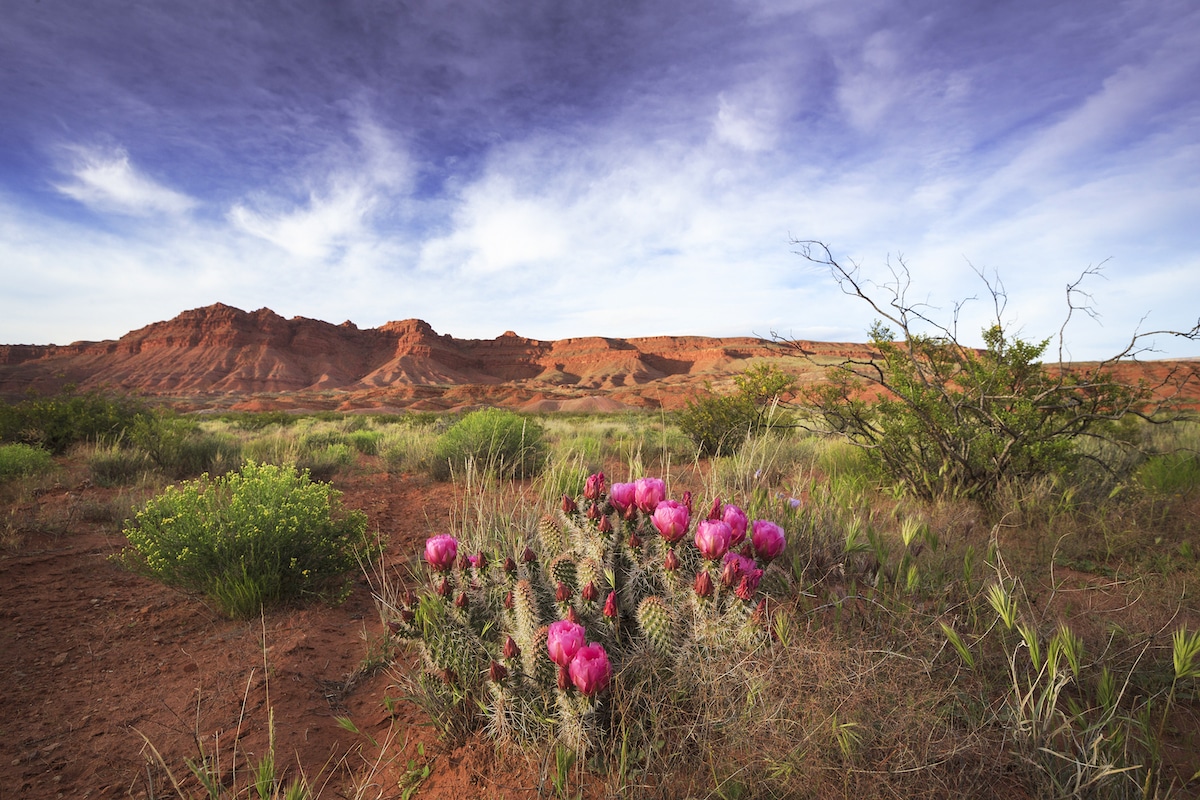
A spring prickly pear blooming in the Utah desert
2. Get an early start
Hiking in the desert can be HOT, and often in the desert, you are completely exposed to the sun with little to no shade. If you plan to hike in the desert when it’s hot outside, start hiking before sunrise.
Even though I hate setting my alarm that early, it’s always worth it to get a headstart on the day while enjoying the sunrise and the cooler morning temps. You also won’t feel as rushed on the trail if you give yourself ample time with an early start.
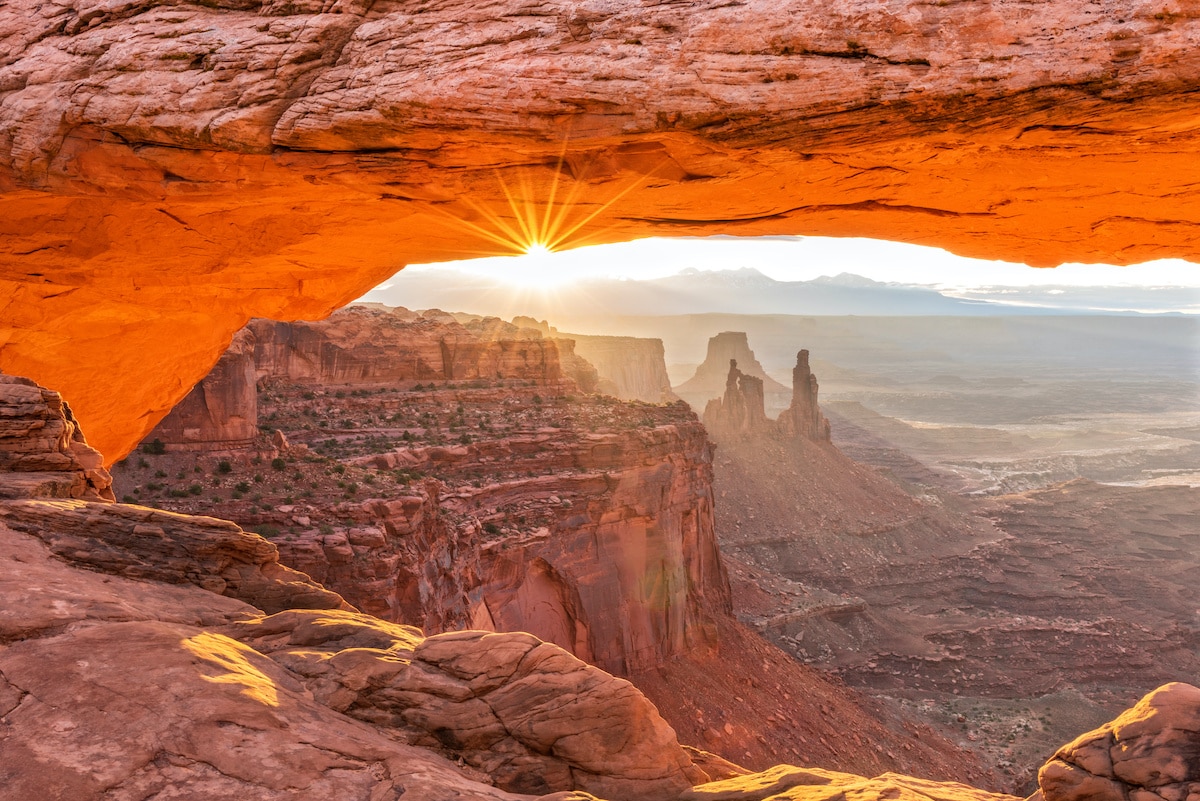
If you wake up early, you may even see an epic sunrise like this one at Mesa Arch in Canyonlands
3. Take breaks in the shade
The desert is usually hottest between 10am to 4pm. If you’re out on the trail during these hours, whatever you do, don’t take your lunch break in the direct sun. This will zap your energy and only leave you more tired.
Instead, wait to break until you find a shady spot – whether than be against a bush or on the ground behind a rock. You may have to get creative looking for shade since you might not be able to find a tall tree like you would in the mountains.
If you are backpacking, you might even consider taking an afternoon cat nap in the shade, while you let the heat of the day pass.
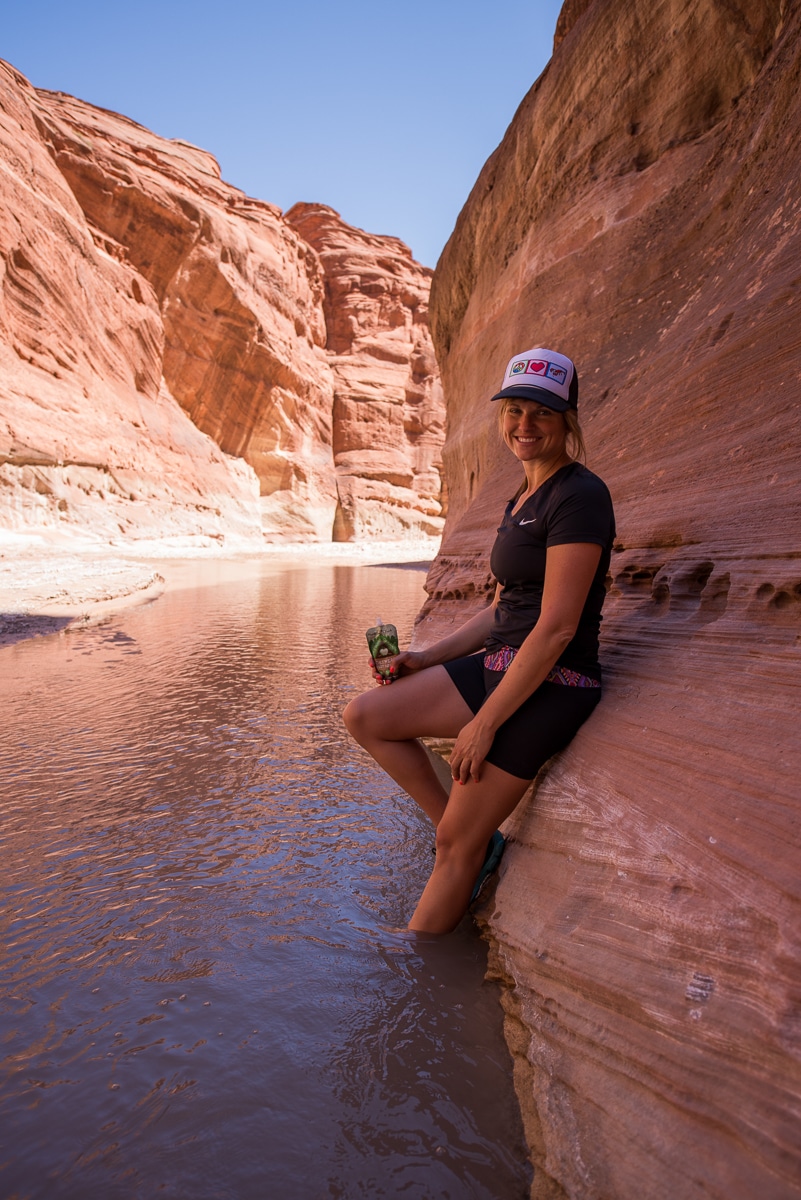
Taking a snack break in the shade against a rock in Paria Canyon
4. Keep an eye out for cairns
A rock cairn is a human-made rock formation of stones piled on top of each other. Their purpose is usually to help hikers navigate the trail, which can be helpful while hiking in the desert in sections where it might be unclear where to go.
Although you may have good intentions, you should NOT build cairns for fun. Only park rangers, trail maintenance volunteers, or trail creators should create new cairns; otherwise, they could send hikers in the wrong direction or misrepresent the trail.
Building a cairn also disrupts the natural ecosystem and alters nature for the next visitor while leaving a reminder you were there. Per Leave No Trace principles, you should leave no sign whatsoever that you were on a trail, which means not creating new cairns.
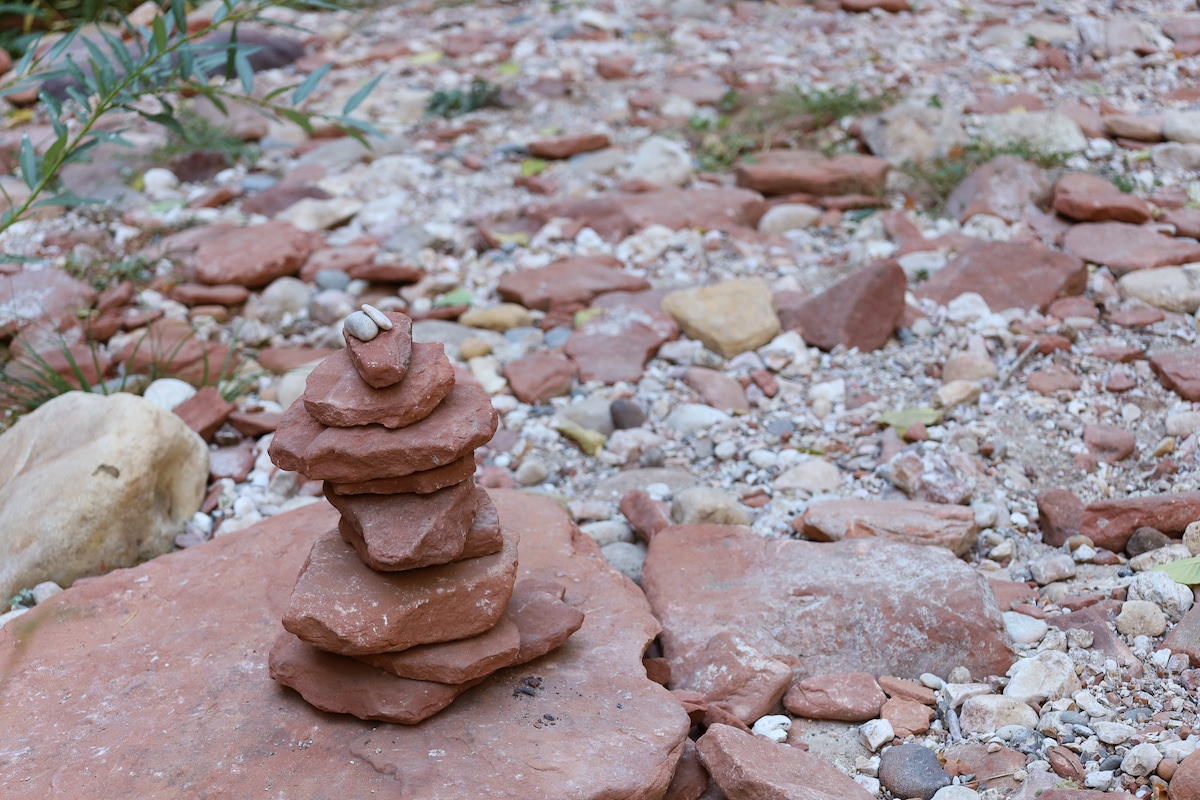
Follow Leave No Trace principles by not creating new rock cairns on the trail
5. Choose trails with shade and water
Research the trail you plan to hike to make sure there is plenty of shade and water. Shade provides relief from the sun, helping you regulate your body temperature on the trail and prevent overheating.
Not all trails in the desert have water sources, but those that do are a great choice. You can dunk your buff or hat in the water to cool off, and if you carry a water filter, you won’t have to pack as much water.
With that said, water sources in the desert can also dry up during certain parts of the year, so make sure you check current conditions before you go and plan accordingly.
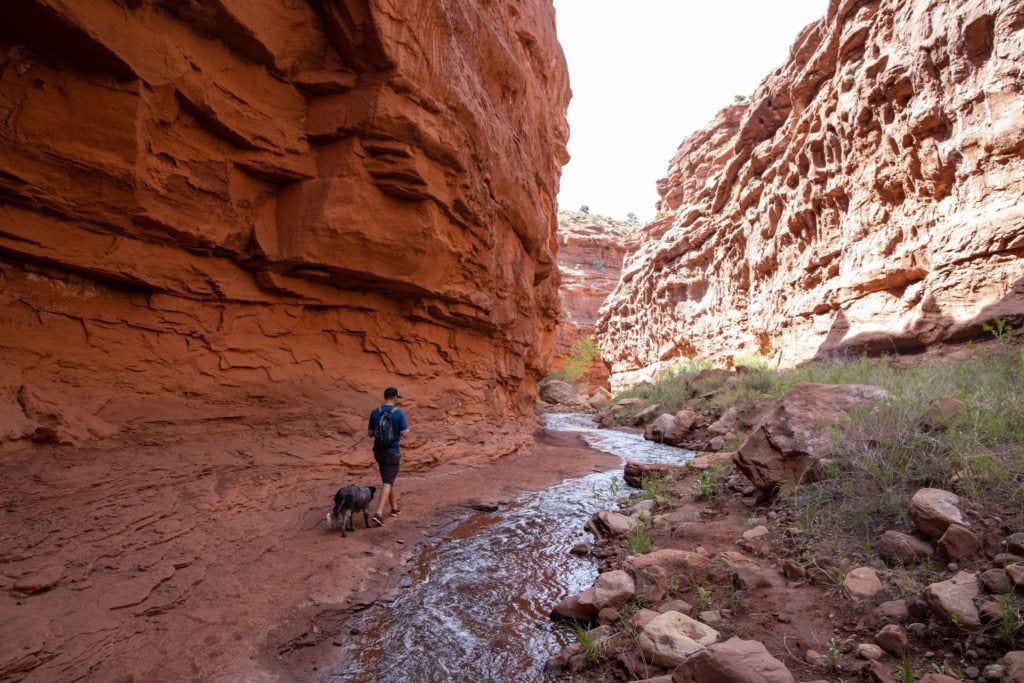
Hiking Mary Jane Falls in Moab, Utah where water and shade are plentiful
6. Don’t bust the crust
In certain areas in the Southwest, there is a bumpy layer of cryptobiotic soil made up of microorganisms. This fragile soil is crucial to desert environments because it helps prevent soil erosion, absorbs water, and improves nutrient availability for new growth.
Desert hikers often accidentally damage cryptobiotic soil because they are unaware of what it is or its importance in preventing desertification. With just one step, it can be damaged, and it can take thousands of years to reform in the desert.
The best way to protect cryptobiotic soil is to not go near it, stay on the trail, and make sure your dog doesn’t step on it. Without cryptobiotic soil, nothing new can grow, and the plants and animals that rely on it will not survive.

You may not notice cryptobiotic soil at a glance, but it’s vital to the desert ecosystem
What to Wear Hiking and Backpacking in the Desert
Conditions in the desert can be unforgiving, so bringing the right gear and wearing the right clothes while hiking and backpacking can make all the difference. Here is what I recommend wearing for a desert hike.
7. Cover your skin
You may think that a tank top and shorts would keep you cool in the desert. However, having direct sun contact on your skin can actually leave you hotter and sunburnt. So despite the heat, you should also try to cover as much skin as possible.
I always look for clothes made with sweat-wicking fabrics. Loose, long pants and lightweight, long-sleeve shirts, like the Patagonia Capilene Cool Daily Shirt, provide coverage without being unbearable.
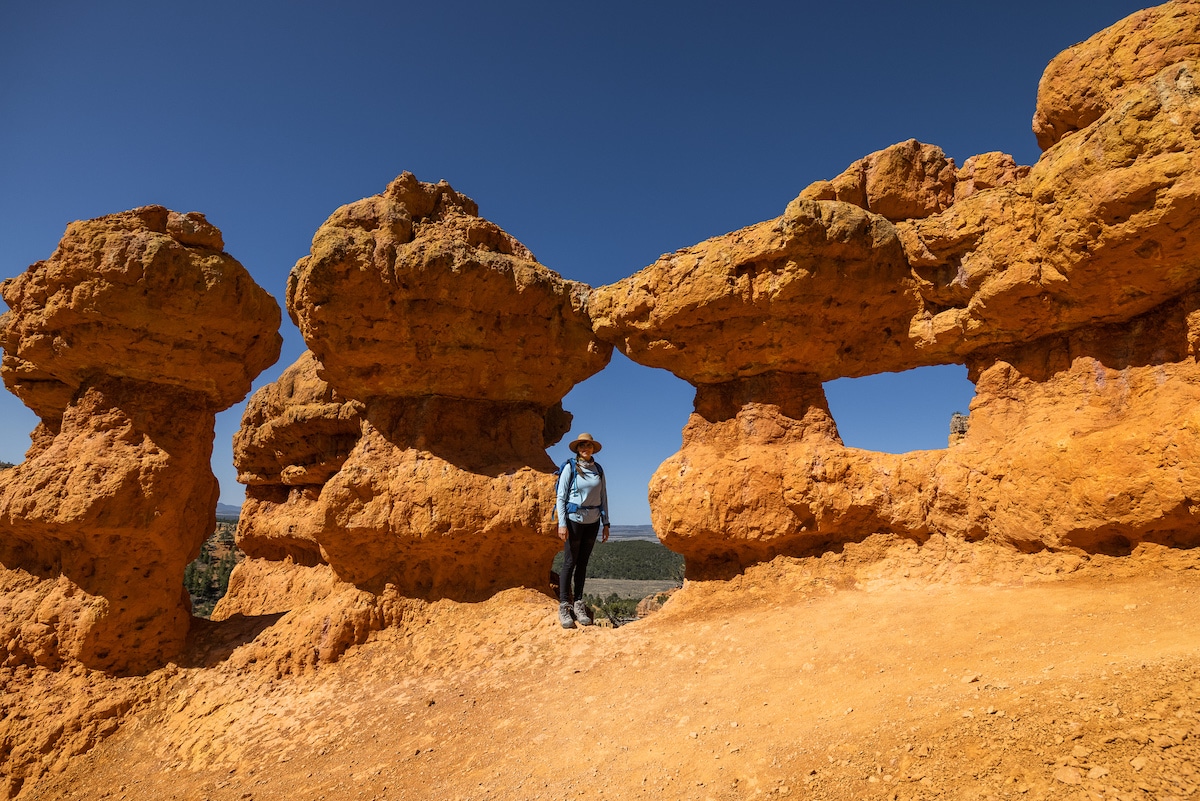
Wearing long sleeves and leggings to shield my skin from the sun while hiking in Utah
8. Wear light colors and fabrics
Choose lightweight fabrics and light colors that reflect UV rays. While I usually wear darker colors because they hide dirt better, when hiking in the desert it’s best to avoid wearing colors like black or navy since dark colors absorb UV rays.
This doesn’t mean you always need to wear white while hiking in the desert, though. Just know that lighter colors will help keep you cooler.
9. Wear a wide-brimmed hat
Always wear a hat to protect your face and scalp from getting burnt – ideally a wide-brimmed hat. Some people also like hats with a neck flap that covers the back of your neck and ears while you’re on the trail.
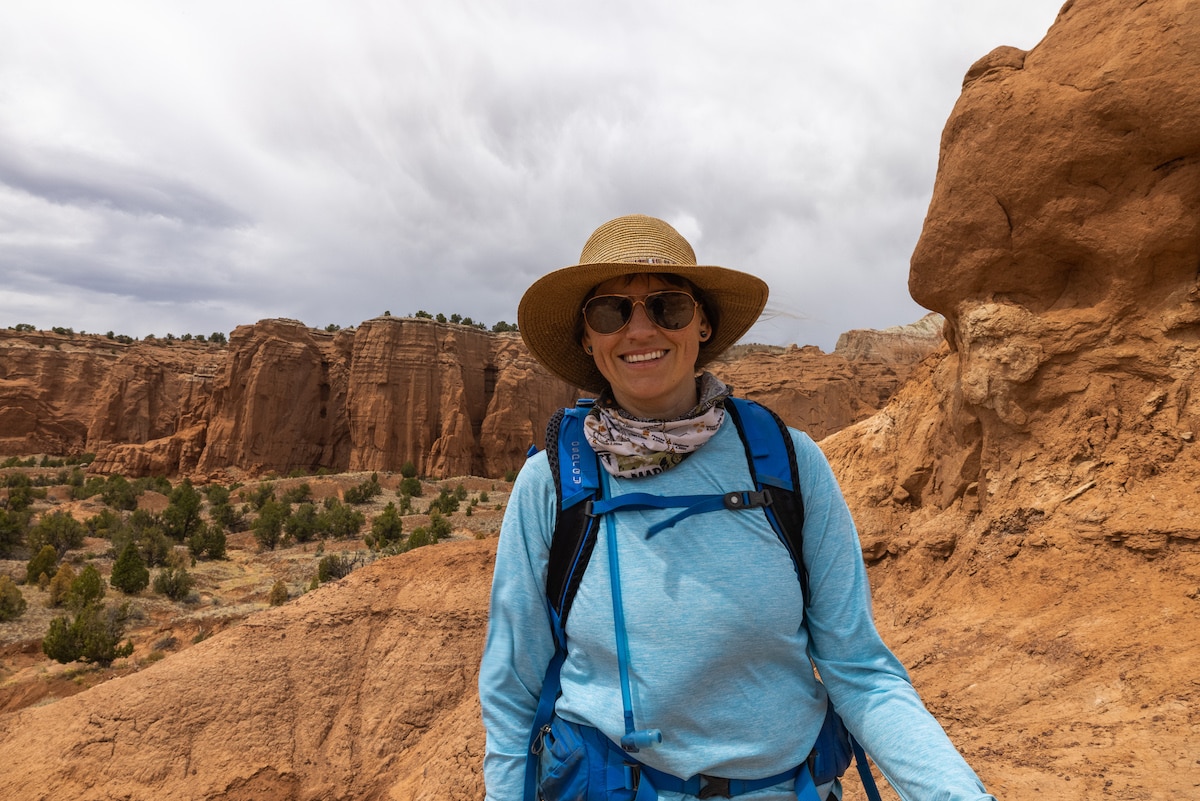
Wearing my wide-brimmed hat while hiking in Kodachrome Basin State Park in Utah
10. Apply sunscreen to exposed skin
Be sure to lather on sunscreen on any exposed areas of skin and reapply every 2 hours. I prefer to use something lightweight that’s easy to apply.
Don’t forget your lips, too! Bring chapstick with SPF to protect your lips from the sun and keep them from getting uncomfortably dry.
11. Wear sunglasses with UV protection
Harsh sunlight can be tough on the eyes. Don’t forget your UV-protecting sunglasses to take pressure off of your eyes and enjoy the views along the trail.
I love my Roka sunglasses because they are lightweight, durable, and have a little flex. They never hurt my nose or ears when I have a hat on. I also like Pit Vipers due to the side-eye protection.
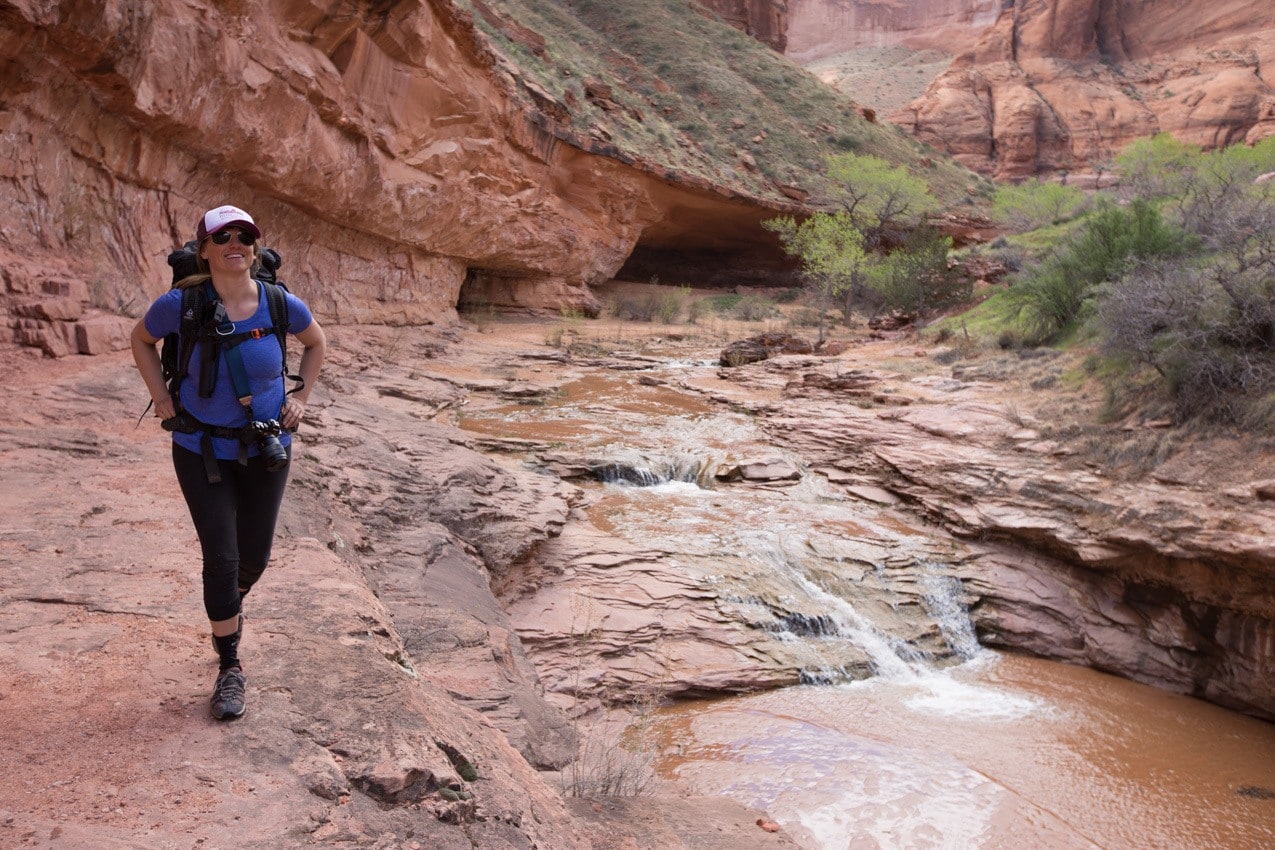
Wearing my shades to protect my eyes while backpacking in Coyote Gulch
No one wants sweaty feet on the trail while hiking in the desert. I recommend wearing desert hiking shoes or boots that are lightweight and breathable yet also durable enough to handle uneven terrain.
When deciding which shoes to wear for a desert hike, look for ones that are designed with good traction and moisture-wicking, quick-drying materials. Unless you’re hiking in winter when there’s a chance of bad weather, avoid waterproof boots for a desert hike since they aren’t as breathable and can cause blisters.
As good as it might feel to walk around barefoot, I don’t recommend doing this in the desert. Many of the spiky and sharp features on the ground would not feel good to step on!
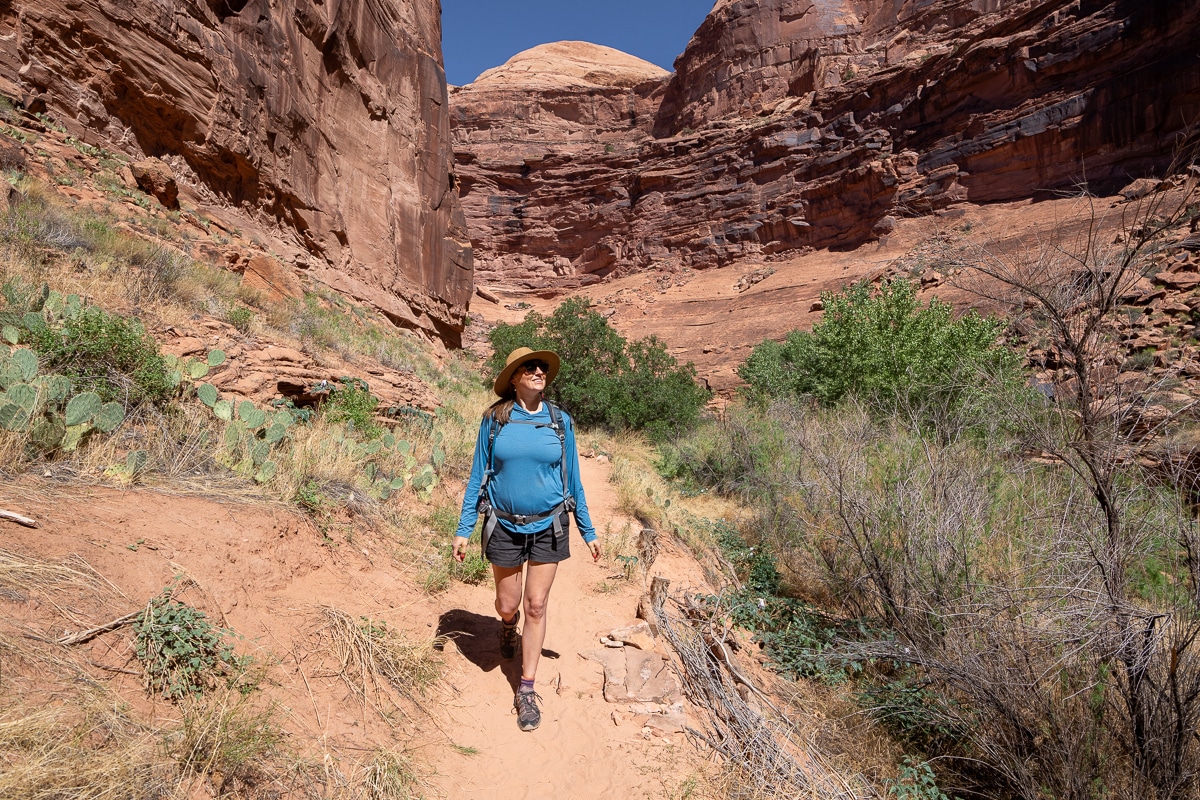
Breathable desert hiking shoes can keep your feet comfortable and protected on the trail
13. Wear a Buff
I love wearing a Buff on hikes. There are so many uses for them!
You can wear it around your neck to protect it from getting burnt (or wet it to help your body cool down quickly) or use it as a headband. You can also use it to prefilter your water or breathe through if the air is dusty. A bandana even works as a makeshift sling in an emergency scenario.
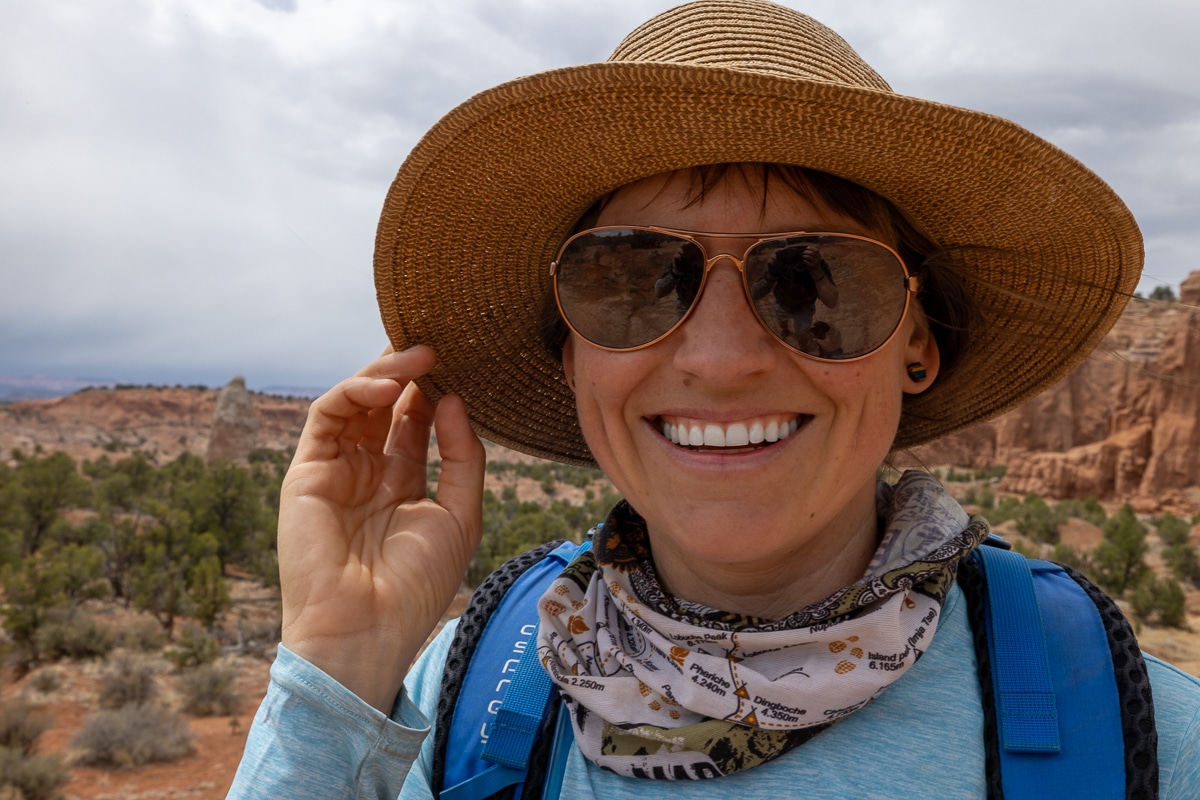
I love wearing a Buff around my neck on hot hikes to protect my neck and keep cool
Gear for Hiking in the Desert
There are some essentials for hiking in the desert that you’ll want to make sure you have in your pack before you hit the trail. To avoid adding unnecessary extra weight to your pack, try to only stick to the items you truly need. Here are my recommendations for desert hiking gear.
14. Pack the 10 hiking essentials
When deciding what to pack, you’ll want to take into consideration how remote, difficult, and long your hike is. For a one-mile hike in a busy National Park, you can approach your gear list more casually.
However, for bigger hikes in wilderness areas where you’re unlikely to encounter lots of other hikers, it’s crucial to pack the 10 Day Hiking Essentials for the desert. Without proper safety gear, an emergency could quickly take a turn for the worse.
While I’ve touched on some of these essentials, the standing recommendation is to pack a first aid kit, knife/multi-tool, way to start a fire, shelter/emergency bivvy, food, extra water, and layers.
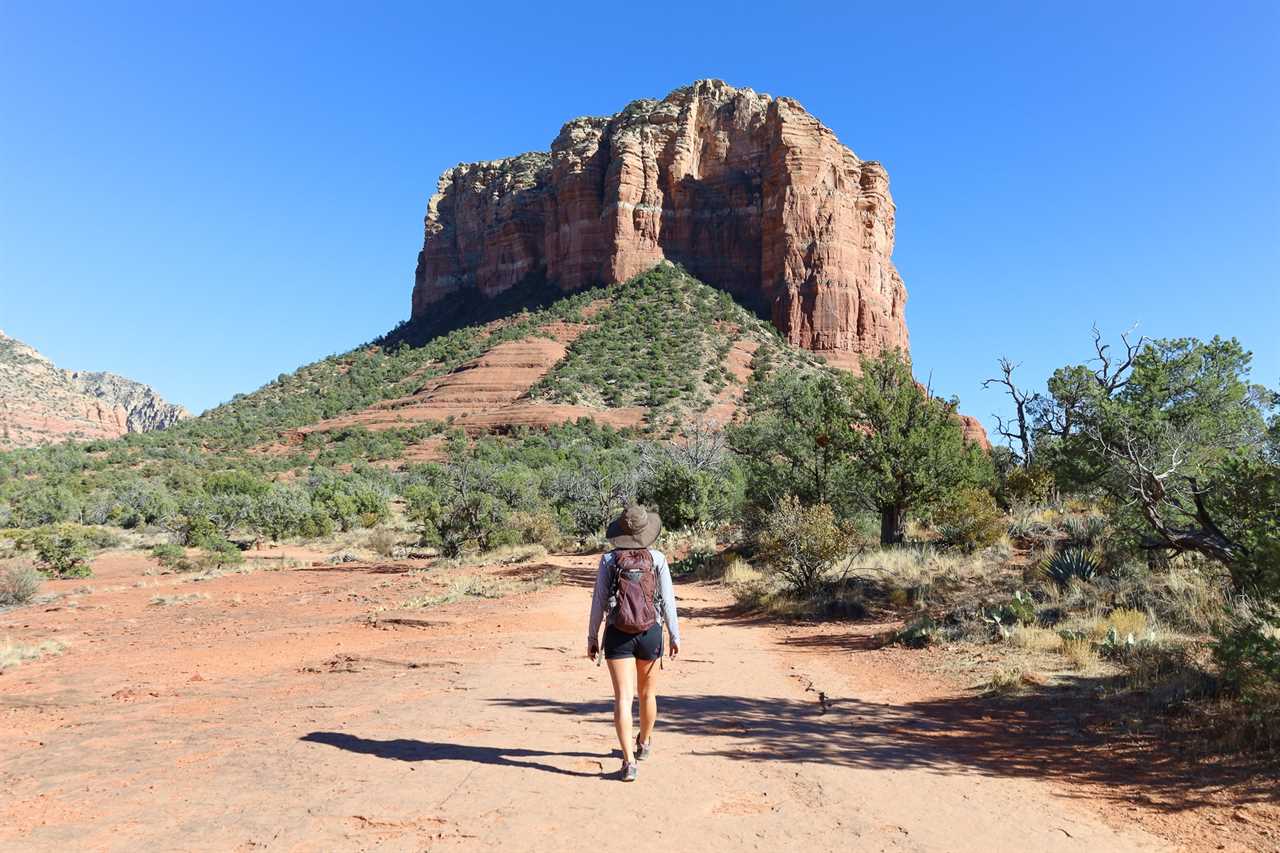
A daypack can hold all of the essentials you need for a desert hike
15. Carry a communication device
When hiking in the desert and other remote areas, I always bring a satellite communication device and GPS, like the Garmin inReach Mini.
Although these communication devices can be pricey, they are worth the investment. Especially when I’m with my partner, Ryan, who hikes with Type 1 Diabetes, it gives me peace of mind to know I can send an SOS message in case of an emergency even when I don’t have cell service.
These devices also allow you to send and receive custom text messages from your contacts and see your exact location on a map so you don’t get lost.
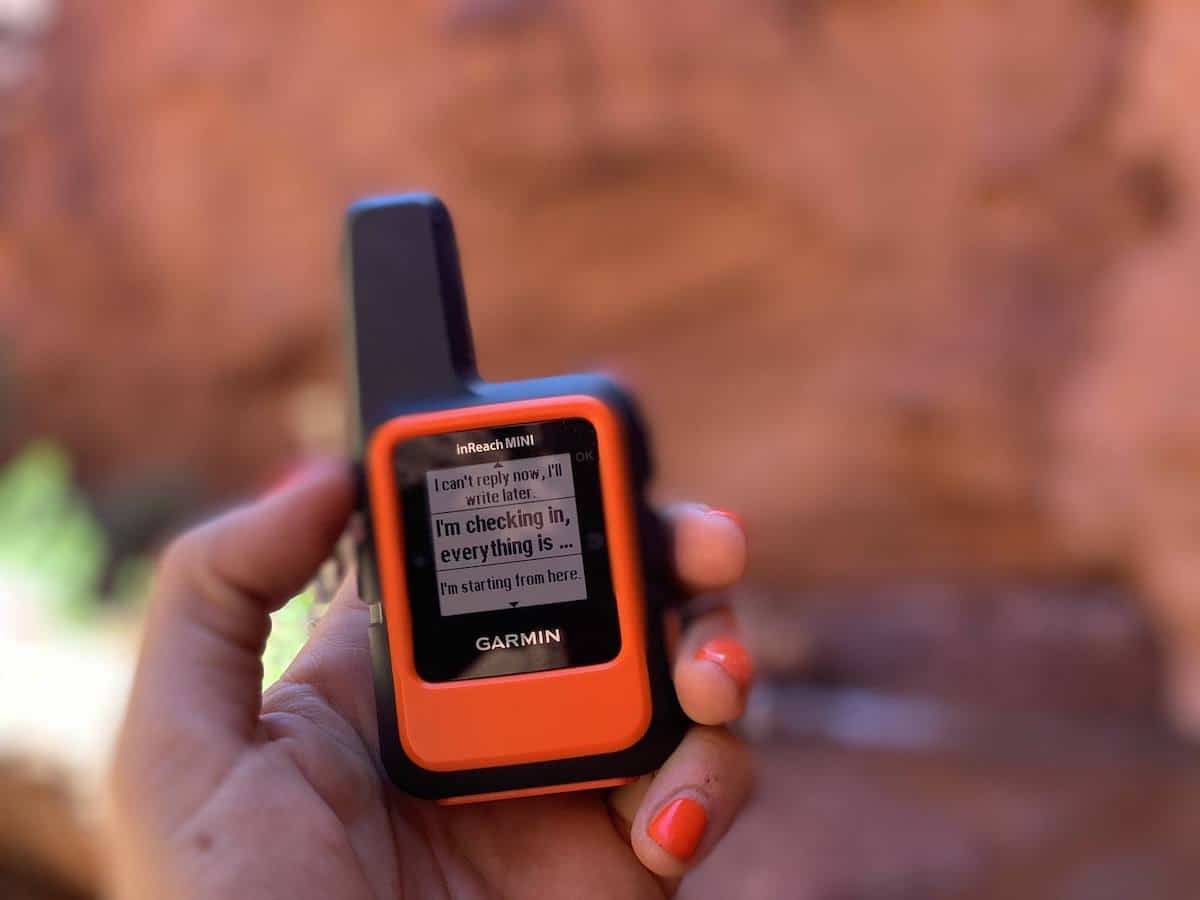
I always bring my Garmin inReach mini while hiking and backpacking
The desert can be a tricky place to navigate. Landmarks aren’t as obvious as they are in the mountains, and visual footpaths aren’t always as easy to see or follow.
Washes, dried riverbeds, and sandy areas can often be easily confused for trails (or sometimes that is the trail!), so pay attention and make sure you know where you’re going.
Always bring a reliable navigation device – whether that be your phone, a GPS, a compass, or a paper map. If you are using your phone, download the map for offline use on your favorite hiking app (this will also help you get back on the trail if you are lost).
Make sure you have a way to keep your phone charged as well if you’re using it as your primary navigation device. Bring a battery pack and/or solar charger and keep your phone on airplane mode to save power.
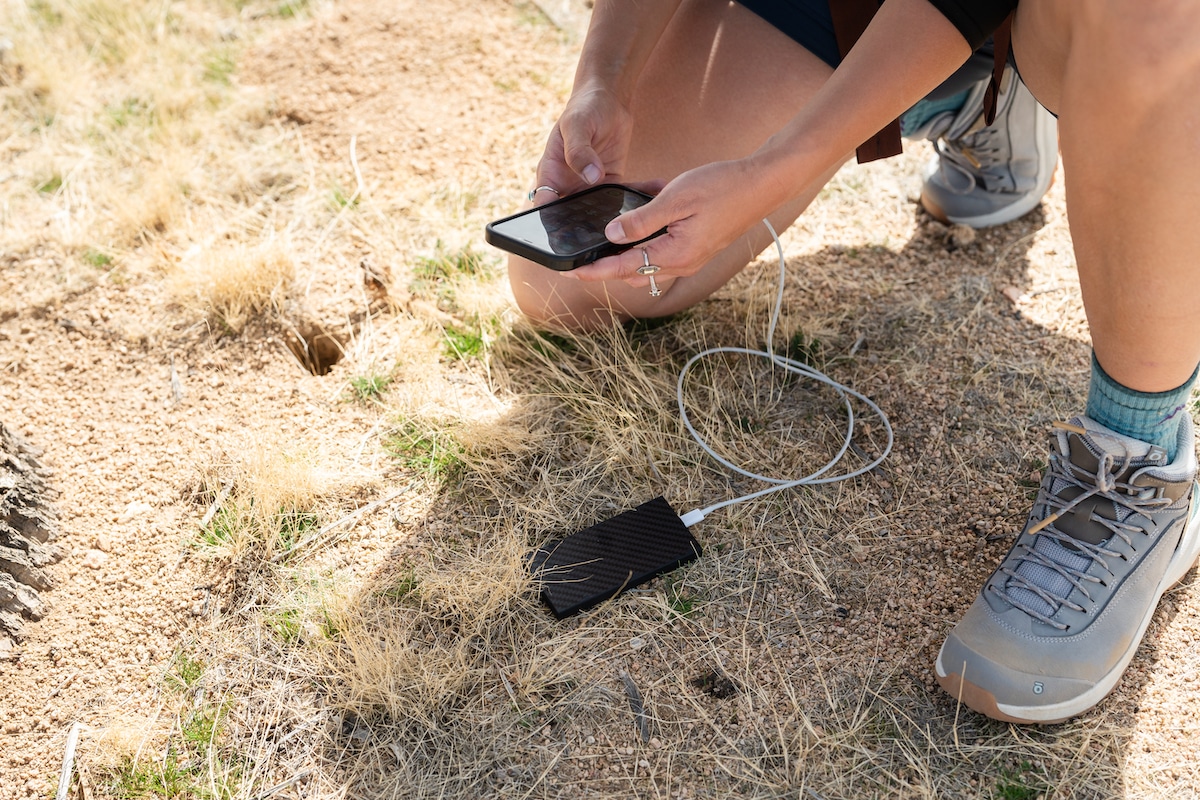
If your phone dies on the trail, you can quickly charge it with a portable energy brick
17. Carry a hiking umbrella
An umbrella is an important piece of gear for hiking in the desert. You don’t want to be caught off guard in a downpour especially in the desert as there are often no trees or shelter that you can stand under to wait out the storm.
A hiking umbrella also helps shield you from the sun where there otherwise isn’t a lot of shade. I have the Silver Shadow Carbon Umbrella by Six Moon Designs, and it literally feels 20 degrees cooler under the umbrella than it does in direct sunlight.
It weighs only 6.8 ounces, and it’s slender enough to fit in your backpack’s side pocket when you aren’t using it. They also sell a hands-free umbrella kit that you can use to attach it to your backpack.
Safety Tips for Desert Hiking and Backpacking
When hiking in the desert, you must take extra safety precautions to prepare for the heat. Here are some tips to ensure you have a safe and enjoyable time on the trail.
18. Have a desert hiking safety plan
When formulating a safety plan for your desert hike, base it around the least experienced or abled person. The slowest hiker determines how much ground the group can cover.
You should be realistic about your goals. If you’re a beginner desert hiker, start with shorter, easier, well-marked trails. It’s also good to have an established turnaround time (even if this means not finishing the hike) so you don’t get caught in the dark or run out of water.
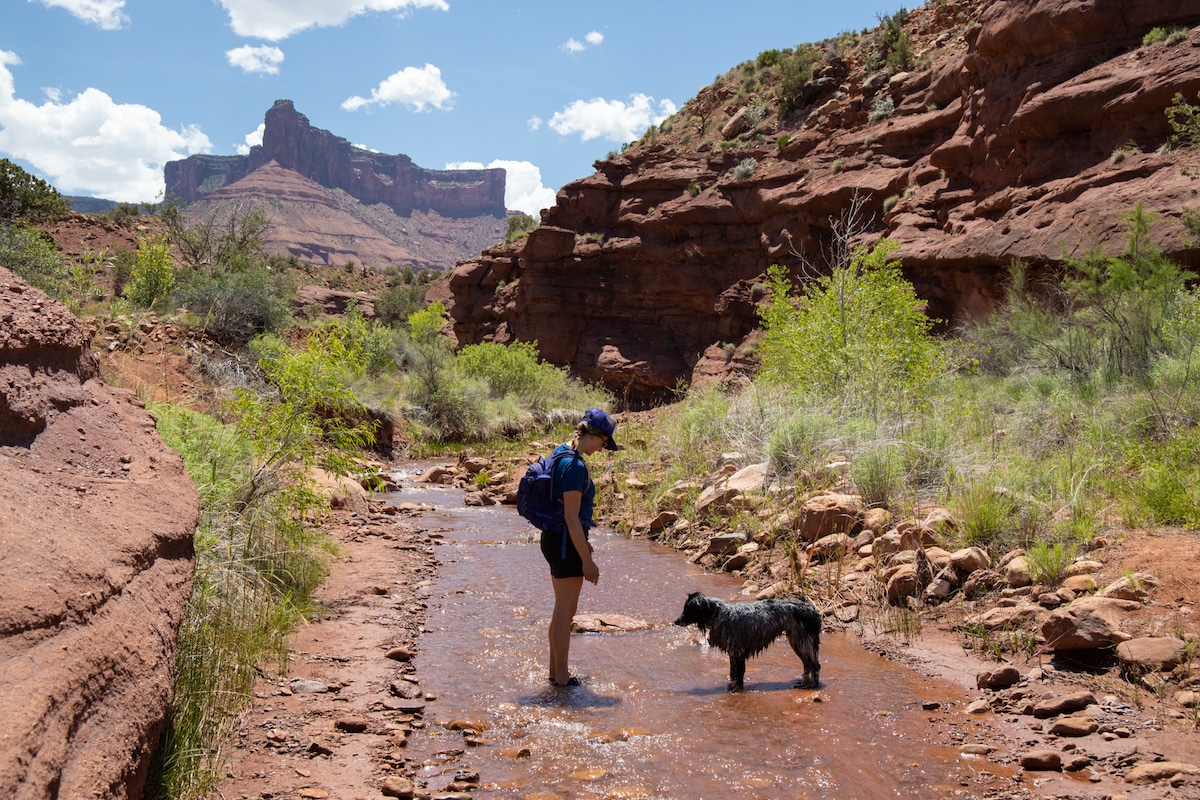
If you’re a beginner desert hiker, I recommend sticking to easy trails at first
19. Tell someone about your hiking plans
While this is something you should always do when you hike (especially if you hike solo), a vital piece of advice for desert hiking is to always inform someone of your hiking plan.
Tell this person your start and end times (including when you expect to be back in cell service), the trailhead and trail info, and who you’re hiking with. When you’re done hiking, let that person know you’re safely off the trail.
20. Be aware of wildlife
When you’re in the wilderness, it’s important to remember that you are just a guest of the animals that live there. In the Southwest, common animals include rattlesnakes, coyotes, javelinas, jackrabbits, bighorn sheep, and mountain lions.
It’s especially important to keep an ear out for the warning rattle of a rattlesnake and know how to safely avoid dangerous wildlife encounters. Be alert and if you are wearing headphones, keep one earbud out. If you do hear and see a rattlesnake on the trail, give it space and don’t make any sudden movements that might freak the snake out.
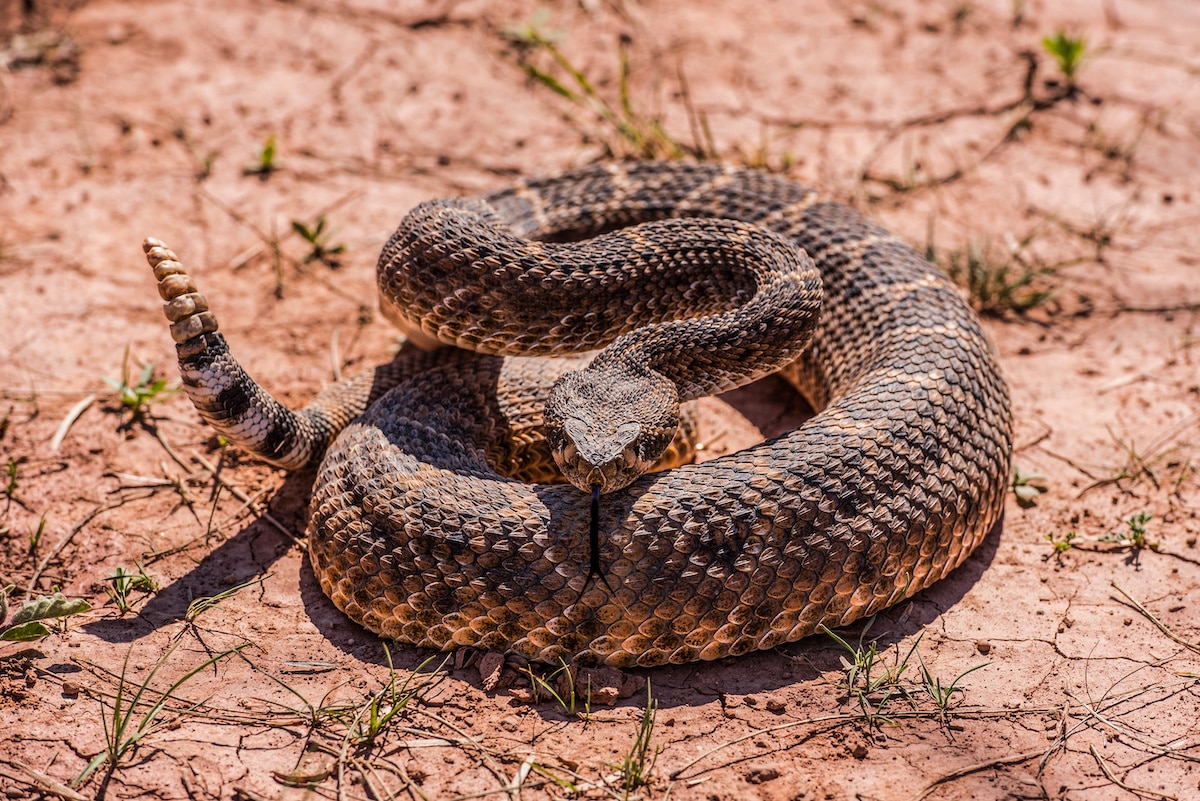
Rattlesnakes often blend in with the desert environment, so stay alert and listen for their rattle
21. Know the signs of heat exhaustion
Make sure you don’t push your limits in the desert and know the signs of heat exhaustion. Some common signs include heavy perspiration, fatigue, lightheadedness, nausea, muscle cramps, headache, goosebumps, high body temperature, fainting, and rapid heartbeat.
If you or someone you’re hiking with begins showing signs of heat exhaustion, act quickly so it doesn’t lead to heatstroke. Move to a cooler place, hydrate with water and electrolytes, loosen or remove clothing, and apply cool, wet rags to the skin.
22. Look out for cacti
Another desert hazard is cacti and other pointy plants. Staying on the trail and watching your surroundings will help you avoid brushing up on any plants. Carry tweezers in your first aid kit to be able to extract any needles should you get poked.
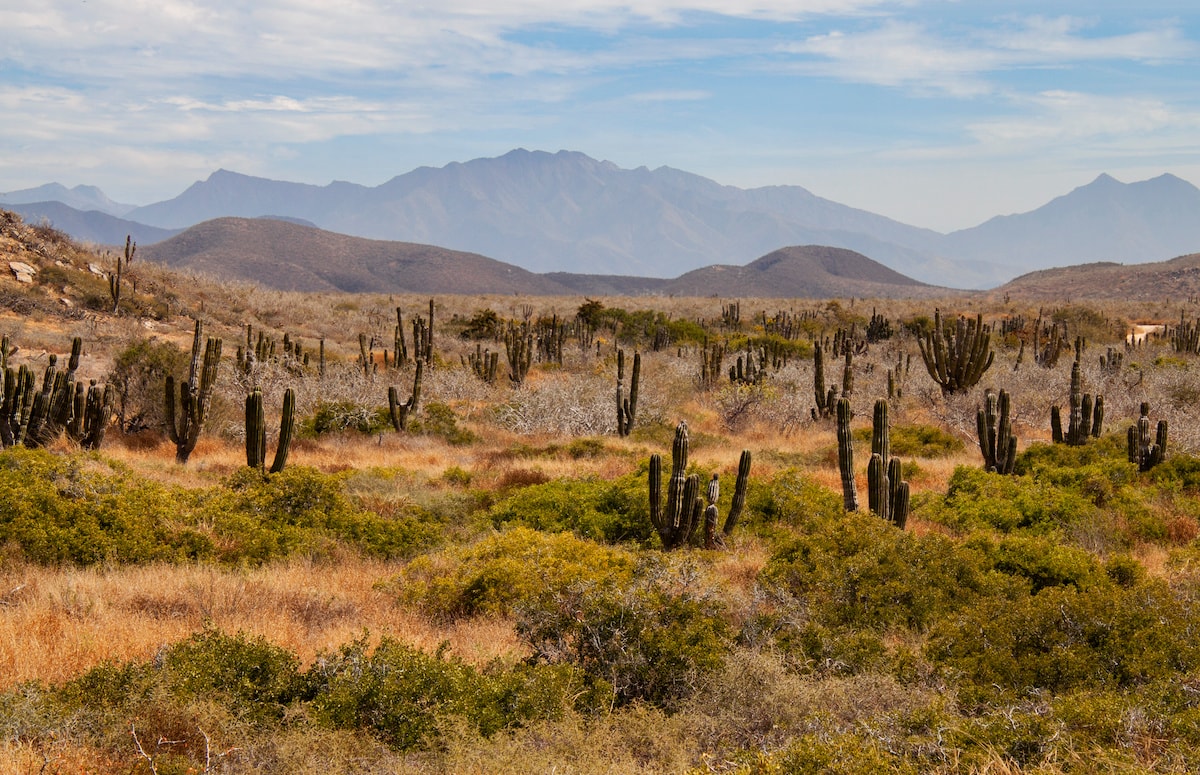
Cacti are beautiful to admire from a safe distance, but be careful not to get too close
Staying Fueled on Your Desert Hike
Staying hydrated and nourished on the trail is one of the most important desert hiking tips. Following these fuel suggestions can help you make sure your body gets the energy it needs.
23. Stay hydrated
It’s always recommended to carry extra water on you in the desert since there aren’t rivers and streams to refill like there are in the mountains. I personally like hiking with a hydration reservoir because it makes it easy to drink water on the move.
The general recommendation for hiking in the desert is to drink at least 4L per person/day, but on a very hot day when you’re sweating a lot, you might drink more.
24. Pack electrolytes
When you’re drinking that much water, it’s imperative that you also maintain your electrolytes. There is such a thing as overhydrating, and it can lead to the concentration of electrolytes in your body being too low. This actually happened to me once, and I got extremely lightheaded and dizzy and ended up with a medic having to pump electrolytes into me through an IV.
As you sweat, you also lose electrolytes. And since you are more prone to dehydration in the desert, getting enough electrolytes is key to keeping you hydrated and full of energy.
You can get electrolyte tablets or powders (such as Nuun tablets) that dissolve in water, or Salt Stick makes electrolyte capsules or chews that you can easily pop as you hike. If you go with the powder form, I like having a separate water bottle for electrolytes, so my hydration bladder stays clean.
25. Research water availability
This may be the most important desert hiking and backpacking tip. Unlike mountains, which commonly have plentiful water sources, you can easily go long stretches in the desert without a water source, and water sources are less reliable as they can seasonally dry up.
Be sure to call the Ranger Station to get the most up-to-date information on water sources for your hike. Carry a map with all water sources circled, and for longer hikes when you do come across water, chug some on the spot and then fill up before moving on.
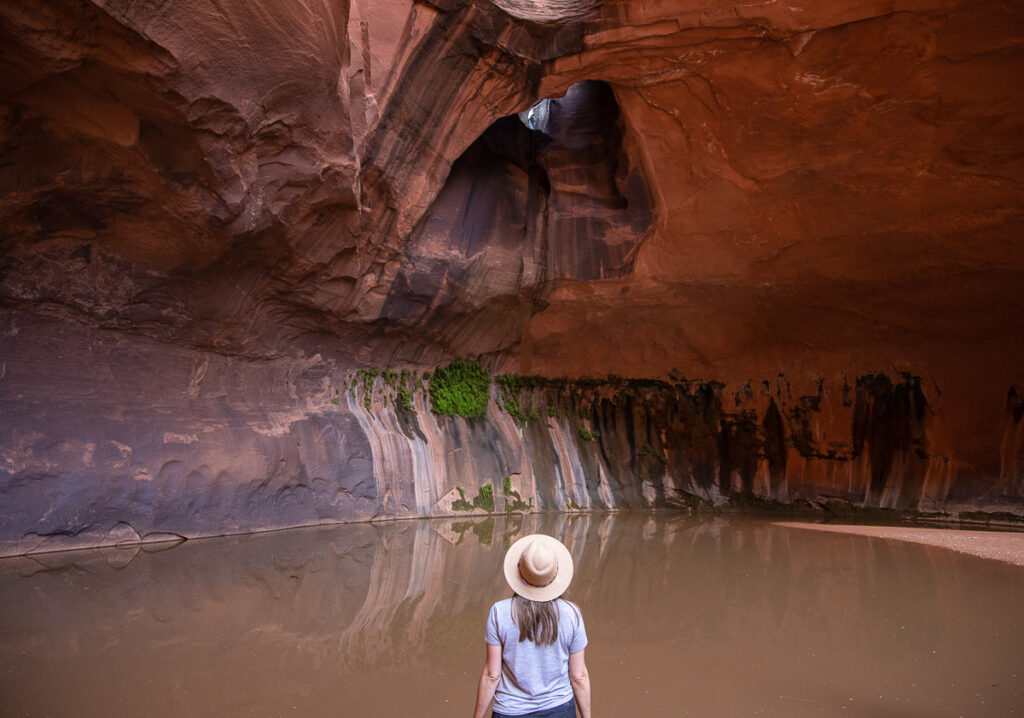
This hike in Escalante has plentiful water
26. Bring a reliable water filter (and a backup)
Water sources in the desert are often stagnant, cloudy, and contaminated by livestock. You need to research these water sources and make sure the filter you bring will work for the source. Your water filters are likely to get clogged and slow to use, so I recommend carrying backup water treatment, like water purification tablets.
For example, if you are filtering from a stream that’s only a couple of inches deep, then something like the popular Platypus Gravityworks which requires you to fill up a big bag of dirty water before filtering may not work. Instead, you might need something like the Sawyer Squeeze or the MSR Trailshot.
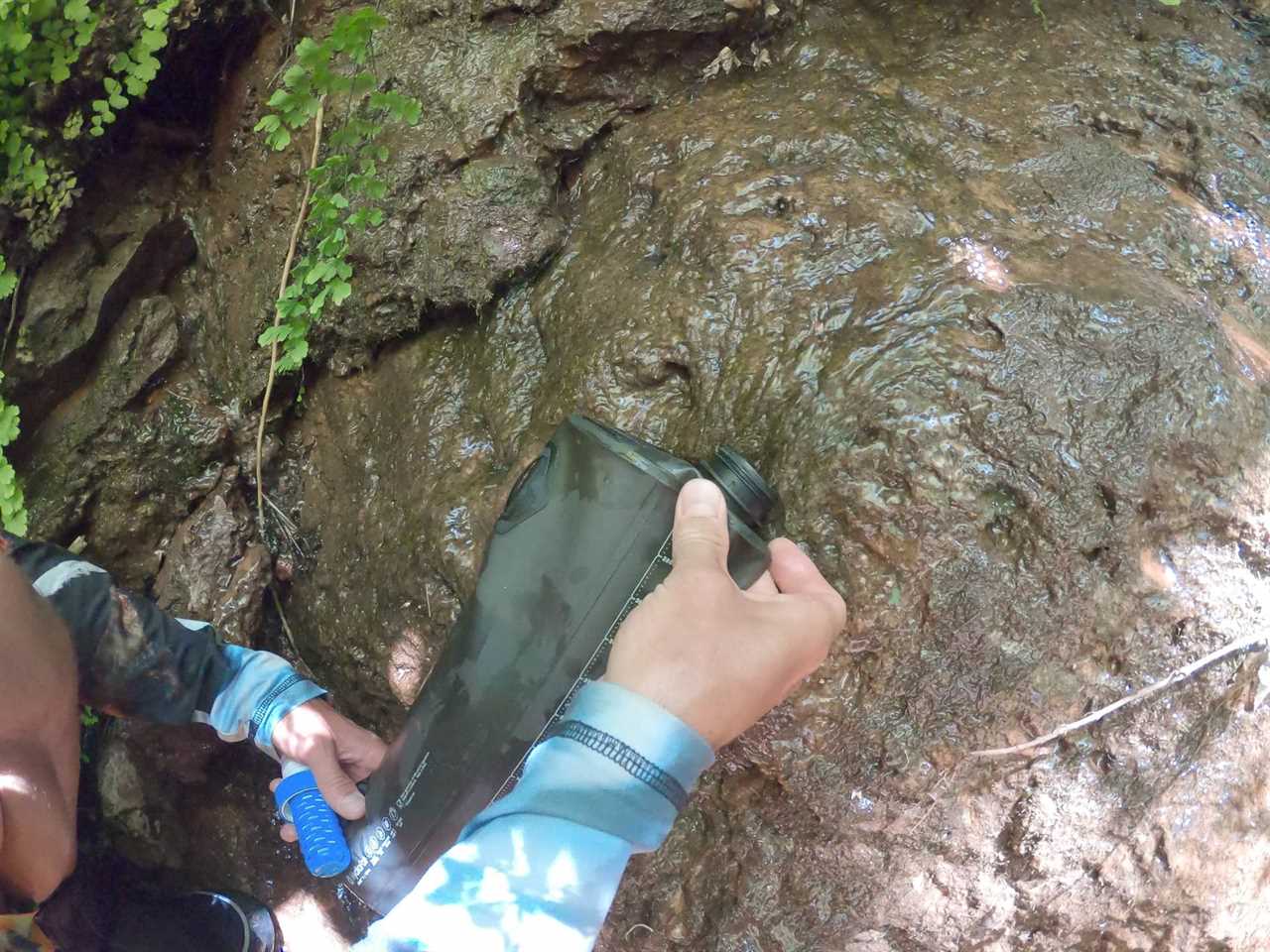
Some desert hikes will have ample water availability, which is ideal
If the water is contaminated with more than your usual bacteria, then you might need a purifier that will work against viruses. If the water is full of sediment, you may need to pre-filter using a bandana and also the Steripen which uses UV light to kill bacteria will not work.
Case in point, you need to make sure whatever method you plan to use will work in the desert environment.
27. Pack salty snacks
Pack salty snacks will actually help your body retain water. Here are some of my favorite desert hiking snacks:
- Salted nuts
- Protein Bars
- Peanut Butter Pretzels
- Nut butter with apple
- Trail Mix
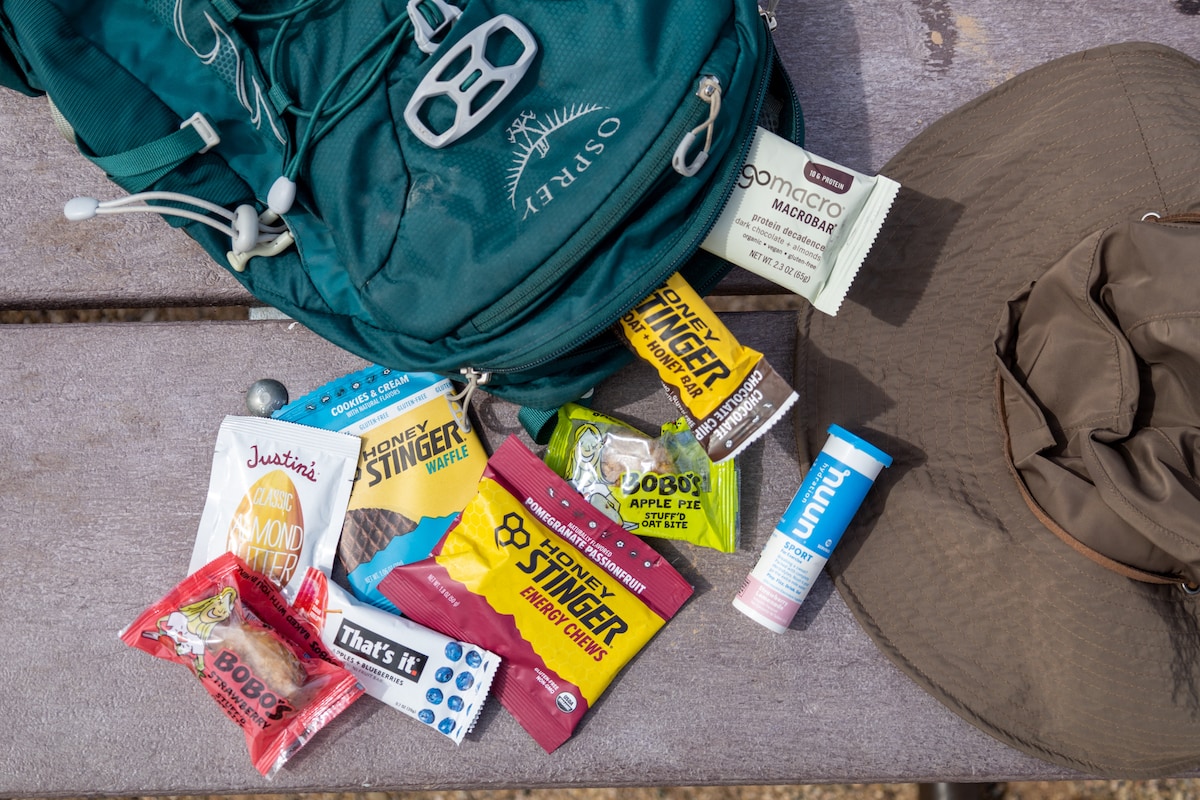
There are so many hiking snack options out there to choose from for your desert hike
Desert Backpacking Tips
While desert hiking and backpacking tips often overlap, these are unique to desert backpacking. If you’re planning to stay in the desert backcountry overnight, use these tips to help you make sure you have an enjoyable (and safe) trip.
28. Pack Light
Since you will likely be carrying more water than your usual backpacking trip, it’s important to keep your desert backpacking gear as light as possible and pack lightly.
Now, this doesn’t mean skipping on the backpacking essentials, but anything you can do to slim down your load will make a world of difference when you’re carrying a pack heavy with water (for reference, 1 liter of water weighs roughly 2.2 lbs).
Swapping out your usual gear for a tarp-style tent, an ultralight quilt, and an ultralight backpack will go a long way in reducing your base weight. You’ll also want to plan out your meals so you aren’t carrying an excessive amount of extra food, and you should also choose foods that have a high calorie-to-weight ratio.
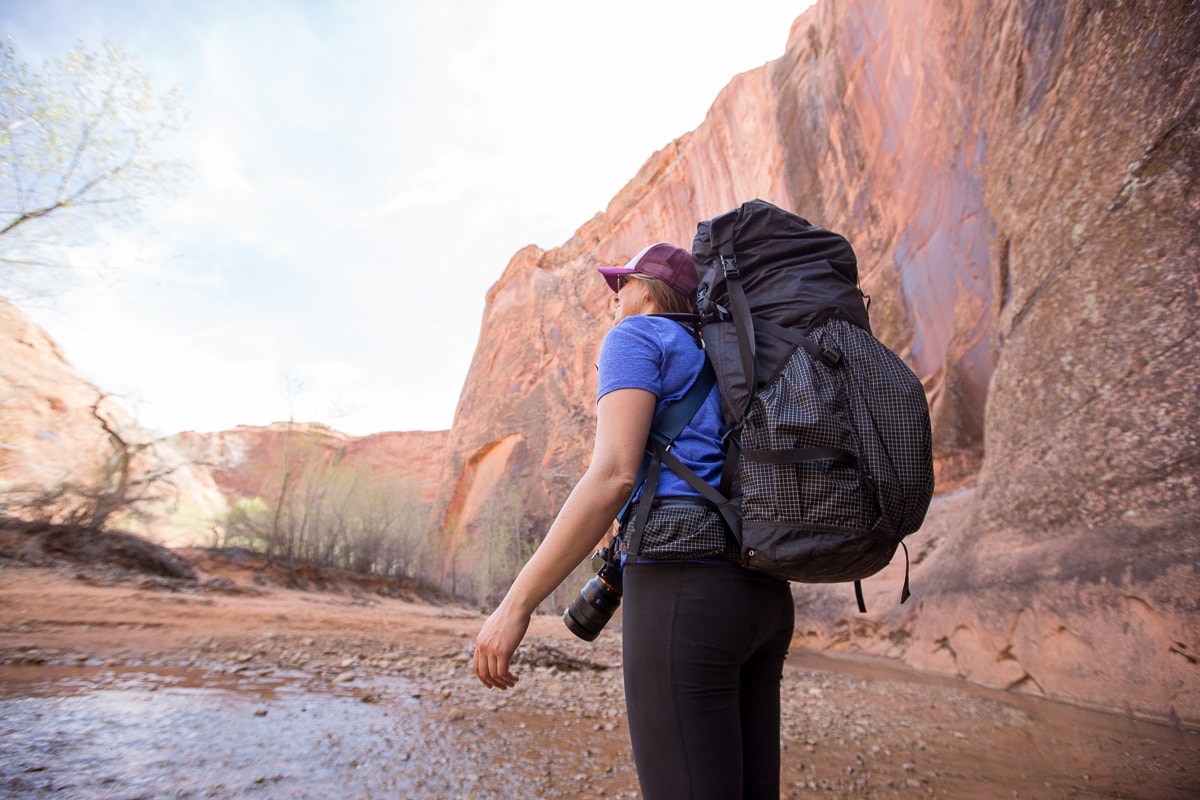
Although it’s tempting to bring comfort items while backpacking, I recommend keeping it light
29. Prepare for cool nights
Although it may feel warm and sunny during the day, the night can be an entirely different story. Depending on the time of year that you backpack, there can be big temperature swings. Frost and freezing nighttime temps are common in late fall, winter, and early spring.
Make sure you bring warm layers to wear at night. You can always remove layers if you get too warm, but you can’t add layers that you don’t have!
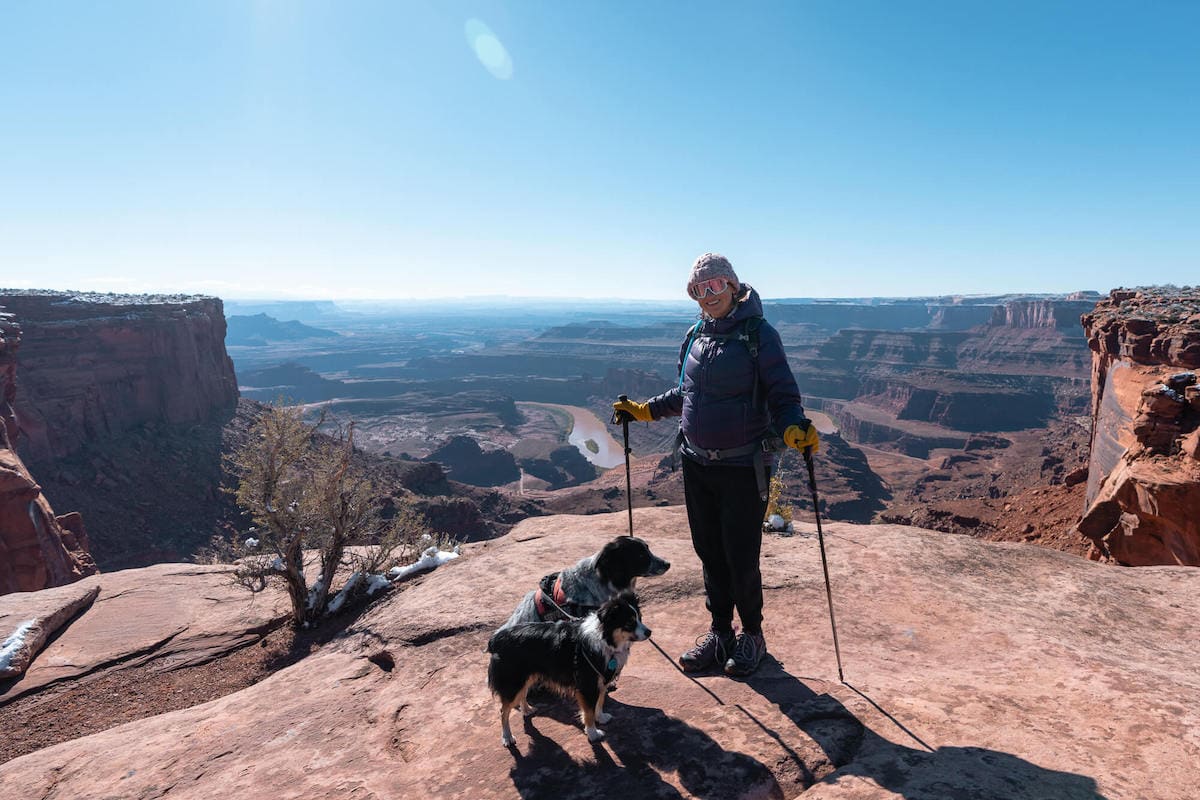
The desert can get chilly, so bring layers to wear in your tent while you sleep
30. Sweep for needles
When you pick a camp, be sure to sweep for loose needles before setting up your tent, and use a ground cloth if you have one. Always carry a patch kit for your sleeping pad just in case yours deflates in the desert.
31. Pack meals that require little water
If you are backpacking in the desert in a spot with limited water sources, prepare meals that require little to no water like peanut butter and jelly sandwiches, bars, wraps, and other hearty snacks, so you can save your water for drinking.
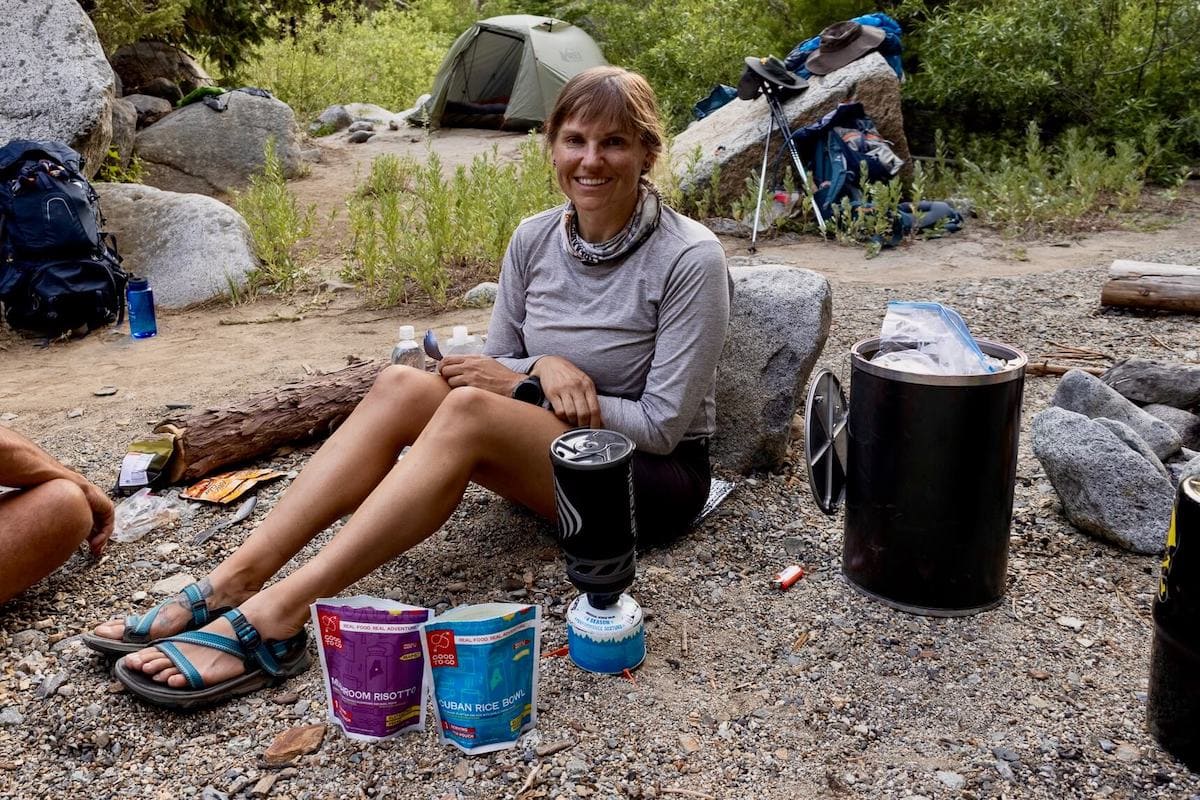
Freeze-dried backpacking meals are convenient only if you’re hiking on a trail with water access
32. Pick the right trail for your ability
The Southwest has PLENTY of desert backpacking trips. It is important to pick one that fits your (and your group’s) physical fitness level. Here are our favorites broken down by state:
Utah
- Paria Canyon: A stunning 4-day/3 night trip hiking down a meandering riverbed in between two enormous walls of Navajo sandstone.
- West Rim Trail: This 2-day/1 night trip in Zion National Park is the ultimate way to avoid the crowds.
- Coyote Gulch: Located in Escalante National Monument, this trip can span 2-3 days and has awesome slot canyons and waterfalls.
California
- California Hiking and Riding Trail: This 35-mile trip located in Joshua Tree National Park is great for beginners as it’s relatively flat and has awesome scenery.
- Trans-Catalina Trail: Located on Catalina Island off the coast of Southern California, this 40-mile trail includes campsites on the beach and epic views.
Arizona
- Havasu Falls – This is a great beginner desert backpacking trip. The campground is located 10 miles from the trailhead, and there is a spigot for you to refill your water.
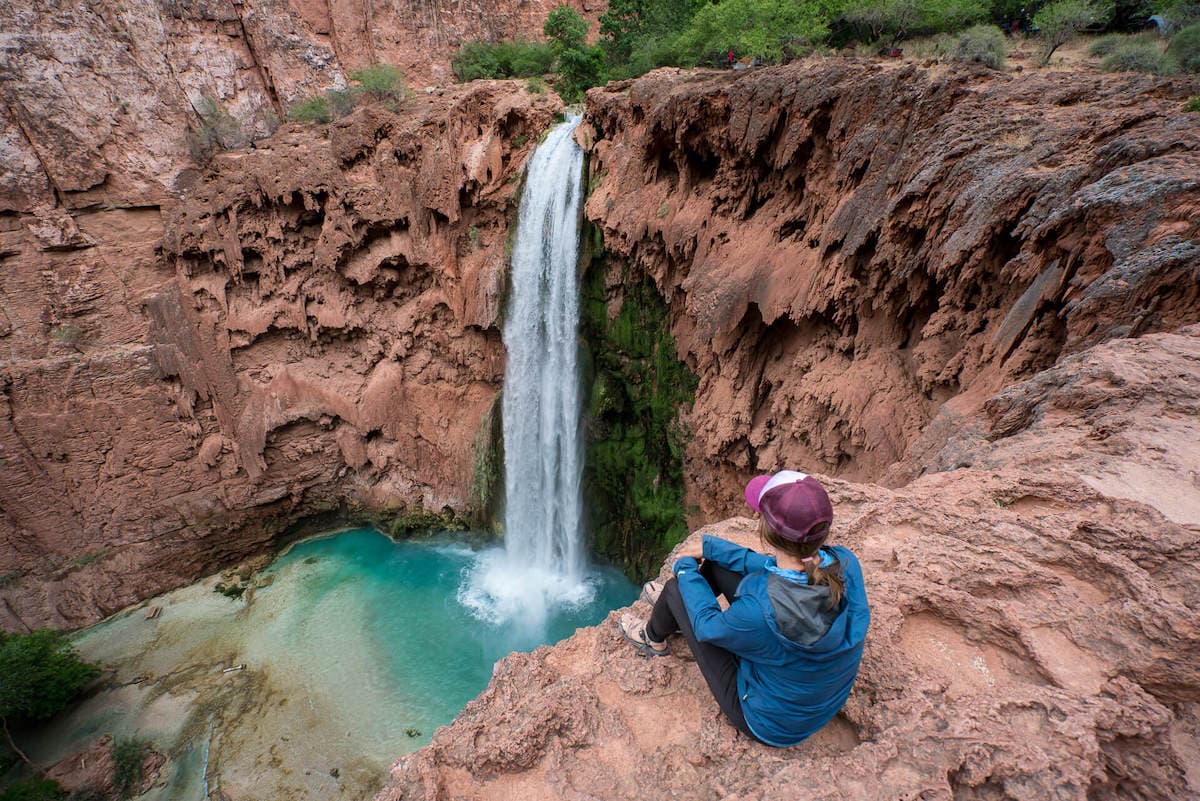
Enjoying the view of Mooney Falls at Havasupai in Arizona
Planning a trip to the desert? Check out these day hikes.
Save this post to Pinterest
Are you planning a desert hike or backpacking trip? If you’ve spent some time in the desert, what are your favorite trails? Leave us a comment below!
The post 32 Essential Desert Hiking and Backpacking Tips appeared first on Bearfoot Theory.
https://bearfoottheory.com/southwest-desert-backpacking-tips/
 CampingSurvivalistHuntingFishingExploringHikingPrivacy PolicyTerms And Conditions
CampingSurvivalistHuntingFishingExploringHikingPrivacy PolicyTerms And Conditions
